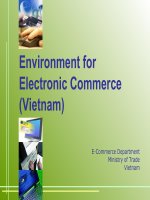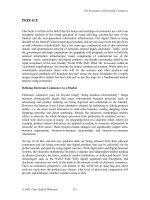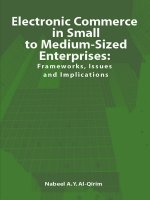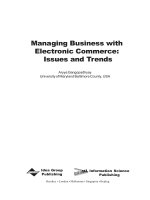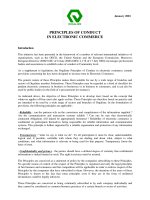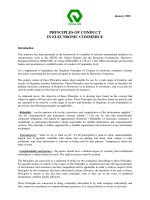Electronic commerce fundamentals ch1
Bạn đang xem bản rút gọn của tài liệu. Xem và tải ngay bản đầy đủ của tài liệu tại đây (613.96 KB, 35 trang )
Chapter 1
1
Introduction to
Electronic Commerce
Electronic Commerce
1
Objectives
Differences between e-commerce and
traditional commerce
◆ Advantages and disadvantages of
using e-commerce to conduct business
◆ International nature of e-commerce
◆ Fostering of e-commerce through
economic forces
◆ Utilizing value chains
◆
1
2
What is Electronic Commerce?
Also known as “e-commerce”
◆ More than on-line shopping
◆ Encompasses other business activities
◆ Used interchangeably with “Electronic
Business”
◆
1
3
EFT and EDI
◆
1
Electronic Funds Transfers (EFT)
● Used
by the banking industry to exchange
account information over secured
networks
◆
Electronic Data Interchange (EDI)
● Used
by businesses to transmit data from
one business to another
4
Traditional Commerce
The exchange of valuable objects or
services between at least two parties
◆ Includes all activities that each party
undertakes to complete the transaction
◆ Barter system eventually gave way to
the use of currency
◆
1
5
The Buyer
Figure 1-1
1
6
The Seller
Figure 1-2
1
7
Activities as Business Processes
◆
1
The activities in which businesses
engage as they conduct commerce are
often referred to as Business
Processes.
● Transferring
funds
● Placing orders
● Sending invoices
● Shipping goods to customers
8
Traditional vs. Electronic Commerce
Figure 1-3
1
9
Business Processes Suitability
Figure 1-4
1
10
Advantages of Electronic
Commerce
◆
Increased sales
● Reach
1
narrow market segments in
geographically dispersed locations
● Create virtual communities
◆
Decreased costs
● Handling
of sales inquiries
● Providing price quotes
● Determining product availability
11
Disadvantages of Electronic
Commerce
Loss of ability to inspect products from
remote locations
◆ Rapid developing pace of underlying
technologies
◆ Difficult to calculate return on
investment
◆ Cultural and legal impediments
◆
1
12
International Electronic Commerce
Language barriers must be overcome
◆ Political structures
◆
1
● Currency
conversion
● Tariffs and import/export restrictions
◆
Legal, tax, and privacy concerns
● Who
has jurisdiction to levy taxes?
● How is personal information handled?
13
The Internet and World Wide Web
The Internet is a large system of
interconnected networks that spans the
globe
◆ The World Wide Web (WWW) is part of
the Internet and allows users to share
information with an easy-to-use
interface
◆
1
14
Origins of the Internet
Developed by the U.S. Department of
Defense in the early 1960s
◆ The world’s telephone companies were
early models for networked computers
◆ Researchers at universities were
connected in 1969
◆
1
15
New Uses for the Internet
◆
● The
1
ability to send messages to one or many
across the Internet
◆
File Transfer Protocol (FTP)
● The
ability to transfer data files from one
computer to another
◆
Telnet
● The
ability to remotely logon to another computer
16
New Uses for the Internet
◆
World Wide Web (WWW)
● The
ability to access information using a common
interface
1
◆
Videoconferencing
● The
ability to use video across the Internet for
conferencing purposes
◆
Multimedia
● The
ability to use video, audio, and animations
across the Internet
17
Commercial Use of the Internet
During the 1980s, the National Science
Foundation prohibited commercial
network traffic on its networks
◆ In 1989, the NSF permitted MCI Mail
and CompuServe to establish limited
connections to the Internet
◆ By 1990, over 300,000 computers were
connected to the Internet
◆
1
18
Growth of the Internet and the Web
Figure 1-5
1
19
Hypertext Markup Language
(HTML)
◆
1
A language that uses codes attached to
text
●
src=“photo.jpg”>
● <a href=“mailto:”>mail</a>
◆
Hypertext links, or hyperlinks, allow the
user to move from one HTML
document to another on a different
computer
20
Growth of the World Wide Web
Figure 1-6
1
21
Economic Forces and
Electronic Commerce
◆
Transaction Costs
● The
1
total of all costs that the buyer and
seller incur as they gather information and
negotiate a purchase-sale transaction
◆
The “Market”
● Potential
sellers must come in contact with
potential buyers
● A medium of exchange must be available
22
Transaction Costs
Brokerage fees
◆ Sales Commissions
◆ Information search and acquisition
◆ Investment in equipment
◆ Hiring of skilled employees
◆
1
23
Markets and Hierarchies
Figure 1-7
1
24
Markets and Hierarchies
Figure 1-8
1
25

